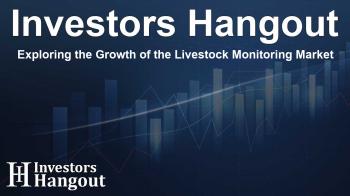Exploring the Growth of the Livestock Monitoring Market

Understanding the Livestock Monitoring Market
The livestock monitoring market is set for significant expansion, expected to reach USD 2.57 billion by 2031 from USD 1.65 billion in 2025, growing at a CAGR of 7.7%. This growth is attributed to the increasing demands for precision livestock farming and the need for real-time health monitoring across various farming types including dairy, poultry, swine, and equine sectors.
Key Drivers of Growth in Livestock Monitoring
Several factors are propelling the growth of the livestock monitoring market. One of the primary drivers is the adoption of smart technologies such as RFID and GPS-enabled tracking systems. These systems enable farmers to efficiently monitor the health and location of their animals, facilitating better management practices that enhance productivity.
Precision Agriculture and Its Impact
As the global agricultural landscape evolves, there is a strong push towards precision farming. This involves using advanced technologies to analyze and optimize farming practices. For example, AI-driven analytics can offer insights into animal behavior, allowing for improved herd management practices. Additionally, IoT cloud integration solutions are helping farmers make data-driven decisions, which greatly enhances operational efficiency and productivity.
Feeding Management: A Critical Segment
An area poised for rapid growth within the livestock monitoring market is feeding management. As sustainable food production continues to gain importance, there is a rising demand for advanced feeding solutions. These systems enable real-time tracking and optimization of livestock nutrition. By using precise data, farmers can adjust diets to enhance milk yield in dairy cattle, for instance, ensuring optimal nutritional composition and minimizing waste.
Emerging Technologies in Feeding Management
Technological advancements like DeLaval's Optimat are revolutionizing how feed is mixed and distributed. This not only improves efficiency but also supports herd health. The trend shows that automated systems can significantly impact feeding practices in swine and poultry farming too. By monitoring feed intake, farmers can prevent the health risks associated with both overfeeding and underfeeding.
Cattle: The Dominant Market Segment
Within the livestock monitoring market, cattle—both dairy and beef—are expected to dominate the market share during the forecast period. The demand for efficient cattle management solutions is escalating, driven by the needs for enhanced disease management and productivity improvements in the meat and dairy sectors.
Technologies Supporting Cattle Monitoring
Livestock monitoring technologies, which include wearable sensors and automated health systems, are invaluable for tracking cattle effectively. These innovations enable farmers to gather real-time data to monitor health, reproduction, and feeding, leading to better decision-making and resource use.
The European Market Landscape
Europe is anticipated to hold the largest share of the livestock monitoring market, driven by advancements in agrotechnology and strong infrastructure supporting sustainable practices. The region has experienced substantial adoption of livestock monitoring technology, with many countries investing heavily in IoT-based solutions to ensure animal health and productivity.
Leading Companies and Innovations
Numerous companies, such as GEA Group, DeLaval, and Nedap N.V., are at the forefront of livestock monitoring innovations in Europe. They are harnessing the power of automated solutions and enhancing animal welfare by adopting sustainable practices. Regulatory systems promoting traceability and food safety are also crucial for the growth of this market.
Conclusion: A Sustainable Future for Livestock Monitoring
As the livestock industry evolves towards sustainability, the monitoring market will continue to grow, propelled by technological advancements and a shift in consumer demand for ethically sourced animal products. This trend not only improves operational efficiency but also aligns with the expectations of modern consumers who increasingly favor responsible and sustainable farming practices.
Frequently Asked Questions
What is the expected growth rate of the livestock monitoring market?
The livestock monitoring market is projected to grow at a CAGR of 7.7%, reaching USD 2.57 billion by 2031.
Which livestock type accounts for the largest market share?
Cattle, encompassing both dairy and beef, are expected to dominate the market share during the forecast period.
How does technology improve feed management?
Advanced feeding solutions optimize nutrition, reduce waste, and enhance productivity by using real-time data for automated adjustments.
Why is Europe leading in the livestock monitoring market?
Europe's leadership is due to significant advancements in agrotech, robust infrastructure, and strong government initiatives supporting sustainable farming.
What companies are key players in the livestock monitoring market?
Key players include GEA Group, DeLaval, and Nedap N.V., which are leading innovations in livestock monitoring technologies.
About The Author
Contact Caleb Price privately here. Or send an email with ATTN: Caleb Price as the subject to contact@investorshangout.com.
About Investors Hangout
Investors Hangout is a leading online stock forum for financial discussion and learning, offering a wide range of free tools and resources. It draws in traders of all levels, who exchange market knowledge, investigate trading tactics, and keep an eye on industry developments in real time. Featuring financial articles, stock message boards, quotes, charts, company profiles, and live news updates. Through cooperative learning and a wealth of informational resources, it helps users from novices creating their first portfolios to experts honing their techniques. Join Investors Hangout today: https://investorshangout.com/
The content of this article is based on factual, publicly available information and does not represent legal, financial, or investment advice. Investors Hangout does not offer financial advice, and the author is not a licensed financial advisor. Consult a qualified advisor before making any financial or investment decisions based on this article. This article should not be considered advice to purchase, sell, or hold any securities or other investments. If any of the material provided here is inaccurate, please contact us for corrections.

